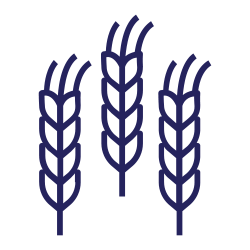The population structure of fusarium pathogens of small grain cereals, their distribution and relationship of mycotoxins
Crop Types
- Barley
- Wheat
Collaborating Locations
University of ManitobaBackground
A better understanding of the factors responsible for the shift in Fusarium population and differences in trichothecene chemotype composition will enable the prediction of future population distribution, possibly related to future changes in climate. Fusarium chemotype diversity may be driven by differences in local selective pressures such as fungicide applications, agronomic practices, host specificity, crop sequence, and weather variables within a region. It may also provide opportunities to identify novel Fusarium populations and trichothecene chemotypes that may pose new threats to food and feed safety in Canada. Information from this study will be important in developing disease forecast models which enable growers to make economic decisions about FHB disease management strategies.
Objectives
- Evaluate Western Canadian population structure and chemotype dynamics of F. graminearum in cereals
- Prevalence, population structure and mycotoxins of F. poae affecting small grains in W. Canada will be studied.
Related Production Resources
Manitoba Crop Alliance’s production resources provide reliable agronomic information based on the latest research. Our resources have been developed to help farmers make productive and sustainable decisions on their farms throughout the growing season.
Related Research Projects

-
Start Date: 2016
-
Completion Date: 2018
-
Project Status: Completed
Given the large value of the farm investment in N fertilizer and expected returns to that investment, Manitoba wheat producers will receive financial benefits from optimizing fertilizer use on individual farms and fields. Read More

-
Start Date: 2015
-
Completion Date: 2020
-
Project Status: Completed
Little is known about how stem properties such as strength, diameter, wall wall width and height contribute to standability and few markers exist to select for preferred traits. This project will identify, dissect, and prioritize traits that contribute to maximum… Read More

-
Start Date: 2019
-
Completion Date: 2022
-
Project Status: Completed
Currently evaluation of moisture resilience by variety is not available for producers, in spite of moisture being the most probable cause for yield reductions. This project will evaluate the performance of MCVET varieties under extreme moisture conditions. Read More

-
Start Date: 2017
-
Completion Date: 2022
-
Project Status: Completed
This information will help producers make decisions on where to focus their input dollars and will provide an opportunity to highlight the effects of PGR’s in spring wheat production. This information can also be used to determine if the variety… Read More

-
Start Date: 2021
-
Completion Date: 2023
-
Project Status: Ongoing
Generating barley varieties with enhanced FHB resistance is complex because multiple fungal compounds and plant genes influence disease severity. We recently discovered a fungal compound called gramillin that promotes FHB severity in barley and is toxic to plants, killing cells… Read More

-
Start Date: 2021
-
Completion Date: 2023
-
Project Status: Ongoing
Preliminary observations in Dr. Bakker’s lab have revealed that there are trichomes on the inner surface of the hull; these have never been explored for potential interactions with Fusarium growth. Using field-grown barley, including multiple different lines and varieties, we… Read More

-
Start Date: 2021
-
Completion Date: 2024
-
Project Status: Ongoing
This project aims to establish a simple, rapid and cost-efficient seed testing protocol by using a novel technique, named loop-mediated isothermal amplification (LAMP). Meanwhile, a greenhouse/growth cabinet disease evaluation method will be developed to screen barley germplasm for resistance, and… Read More

-
Start Date: 2021
-
Completion Date: 2024
-
Project Status: Ongoing
This project will aid in the development of long term tools for plant breeders. Read More

-
Start Date: 2020
-
Completion Date: 2025
-
Project Status: Ongoing
The deliverables of this project will complement other national and international efforts for the identification of virulence genes in F. graminearum, which are mainly focused on reverse genetic studies, meanwhile it exemplifies the necessity of integrating forward and reverse genetics… Read More

-
Start Date: 2020
-
Completion Date: 2023
-
Project Status: Ongoing
The benchmark information that will be generated by this project will address the feasibility of achieving simultaneous genetic improvement in grain yield and baking quality-related traits in order to develop more resource-use efficient varieties. Read More

-
Start Date: 2020
-
Completion Date: 2025
-
Project Status: Ongoing
Our work will focus on the development and deployment of appropriate to marker-assisted selection of wheat DNA markers that will facilitate breeding of adapted to the prairie environment elite cultivars. These DNA markers and a germplasm carrying newly discovered resistance… Read More

-
Start Date: 2021
-
Completion Date: 2025
-
Project Status: Ongoing
This project aims to breed more resilient crop varieties in the face of water stress Read More

-
Start Date: 2020
-
Completion Date: 2026
-
Project Status: Ongoing
This project will maintain progress in breeding improved DON resistant barley varieties and to identify new tools to breed for DON resistance. Read More

-
Start Date: 2020
-
Completion Date: 2023
-
Project Status: Ongoing
The long-term goal of this research, is to utilize natural immunity in wheat germplasm to identify new sources of effective resistance. The novel resistance genes identified will eventually be passed on to wheat breeding programs for development of FHB and… Read More
-
Start Date: 2021
-
Completion Date: 2025
-
Project Status: Ongoing
This project will aim to develop new varieties, wth improved yields through the selection of lines with optimal reproductive and spike traits. Read More

-
Start Date: 2021
-
Completion Date: 2024
-
Project Status: Ongoing
Management strategies are being challenged by the rapidly evolving and changing populations of these fungi, which are overcoming disease resistance genes and may be acquiring fungicide tolerance. In addition, these diseases can be caused by several different fungal species as… Read More

-
Start Date: 2021
-
Completion Date: 2024
-
Project Status: Ongoing
This project will investigate the application of RNA-based fungicides to control major diseases of crops grown on the prairies, namely wheat and canola. This approach is based on proven research that has demonstrated that the application of RNA molecules directly… Read More

-
Start Date: 2020
-
Completion Date: 2024
-
Project Status: Ongoing
This project will look at the effect of foliar fungicide strategies on the mitigation of FHB in barley. Read More

-
Start Date: 2019
-
Completion Date: 2024
-
Project Status: Ongoing
The knowledge, germplasm and markers generated from this project will accelerate breeding cycles and benefit the wheat industry. Read More

-
Start Date: 2022
-
Completion Date: 2025
-
Project Status: Ongoing
Recently, an emerging disease caused by pathogenic Xanthomonas translucens known as bacterial leaf streak (BLS) has been reported in a number of fields in western Canada leading to heightened general concerns among wheat growers. This project will gather information on… Read More
Project Details
Field Issues
- Disease


